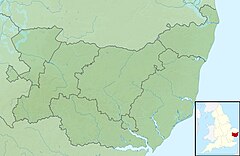The River Blyth is a river in east Suffolk, England. Its source is near Laxfield[1] and it reaches a tidal estuary between Southwold and Walberswick on the North Sea coast.[2]
| Blyth | |
|---|---|
 The River Blyth near Wenhaston. | |
| Location | |
| Country | England |
| Region | Suffolk |
| Physical characteristics | |
| Source | Laxfield |
| • coordinates | 52°17′58″N 1°20′23″E / 52.2995°N 1.3398°E |
| • elevation | 58 m (190 ft) |
| Mouth | North Sea near Walberswick |
• coordinates | 52°18′48″N 1°40′30″E / 52.3133°N 1.675°E |
• elevation | 0 m (0 ft) |
| Length | 30.5 km (19.0 mi) |
Course
editThe course of the river passes through agricultural land between Laxfield and Halesworth, flowing through the estate of Heveningham Hall and the village of Walpole before being crossed by the A144 road and the East Suffolk Line to the south of Halesworth. East of Halesworth the river is canalised in places and has a clear flood plain with land being used as grazing marsh. At Blythburgh it is crossed by the A12 trunk road before entering the estuarine section of the river.
The estuary mouth forms the main harbour area of Southwold and is still an active fishing harbour. The estuary is central to the plot of Peter Greenaway's film Drowning by Numbers, being the scene of the final drowning. The river can be crossed by pedestrians by a public footbridge called the Bailey Bridge about a mile upstream from the sea or by the Walberswick rowing boat ferry.
Navigation
editThe Blyth Navigation canal was opened in 1761 running 7 miles (11 km) from Halesworth to the Blyth estuary, leading to the canalisation of the river east of Halesworth. It was insolvent by 1884, partly due to attempts to reclaim saltings at Blythburgh, which resulted in the estuary silting up and partly due to the opening of the Southwold Railway in 1879. The navigation was used sporadically until 1911, and was not formally abandoned until 1934, when the River Blyth Navigation Act Revocation Order 1934 (SR&O 1934/283) was passed.
History
editThe river gives its name to the settlements of Blyford, indicating a formerly important ford over the river, and Blythburgh. The river's name itself comes from an Old English word blithe meaning "gentle or pleasant".[3]
References
edit- ^ "blythweb.co.uk - Source". Archived from the original on 16 April 2012. Retrieved 6 September 2012.
- ^ "blythburgh.net - Tidal". Retrieved 6 September 2012.
- ^ A. D. Mills. A Dictionary of British Place Names. Oxford University Press.
